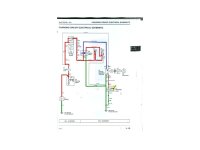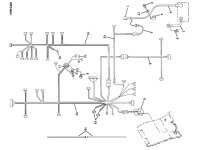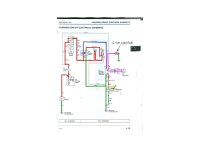jinman
Rest in Peace
- Joined
- Feb 23, 2001
- Messages
- 20,387
- Location
- Texas - Wise County - Sunset
- Tractor
- NHTC45D, NH LB75B, Ford Jubilee
Okay, here is the first diagram and a description of how things work. I have used red to indicate + Battery voltage and Green to indicate - Ground. That way it's easier to follow on a diagram with all black lines.
The state of the system is that the key is turned ON, but the engine has not been started.
Positive power (red) flows from the battery to the starter motor and then through a fusible link to the S1 Key Switch. When S1 is placed at ON, the positive power continues down through Fuse #2 to the base of the K1 Safety Relay. Power is felt at the contact of the relay, but it cannot pass through until the relay coil energizes to close the contact. That path is provided by the V1 diode and over to the negative side of the V2 diode. Since V2 is reverse biased, no current flows through it. The positive power contines from the junction under V2 back to the left to the coil of K1 Safety Relay and across the coil to ground (green).
When the coil energizes, it closes the K1 contacts and positive power flows through the contacts (shown as blue for clarity) over to the Voltage regulator via a yellow wire. This signals the voltage regulator to turn ON and be prepared to regulate the power from the dynamo alternator when it begins to have an output. It also sends positive power to the battery discharge light on the instrument panel.
Smitty, what I want you to do is to verify that power is getting to relay K1 and that it is operating as it should. You should see battery voltage at the yellow wire to the VR when the key is turned ON and it should go away when the key is turned OFF. That's the first check I want you to do. If K1 is not operating properly or one of the diodes is bad, we have to fix them before we can proceed. Feel free to ask for any clarification.
The state of the system is that the key is turned ON, but the engine has not been started.
Positive power (red) flows from the battery to the starter motor and then through a fusible link to the S1 Key Switch. When S1 is placed at ON, the positive power continues down through Fuse #2 to the base of the K1 Safety Relay. Power is felt at the contact of the relay, but it cannot pass through until the relay coil energizes to close the contact. That path is provided by the V1 diode and over to the negative side of the V2 diode. Since V2 is reverse biased, no current flows through it. The positive power contines from the junction under V2 back to the left to the coil of K1 Safety Relay and across the coil to ground (green).
When the coil energizes, it closes the K1 contacts and positive power flows through the contacts (shown as blue for clarity) over to the Voltage regulator via a yellow wire. This signals the voltage regulator to turn ON and be prepared to regulate the power from the dynamo alternator when it begins to have an output. It also sends positive power to the battery discharge light on the instrument panel.
Smitty, what I want you to do is to verify that power is getting to relay K1 and that it is operating as it should. You should see battery voltage at the yellow wire to the VR when the key is turned ON and it should go away when the key is turned OFF. That's the first check I want you to do. If K1 is not operating properly or one of the diodes is bad, we have to fix them before we can proceed. Feel free to ask for any clarification.



